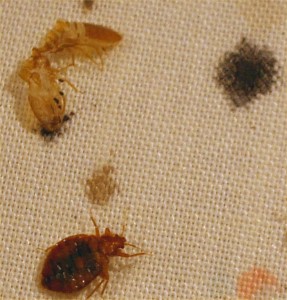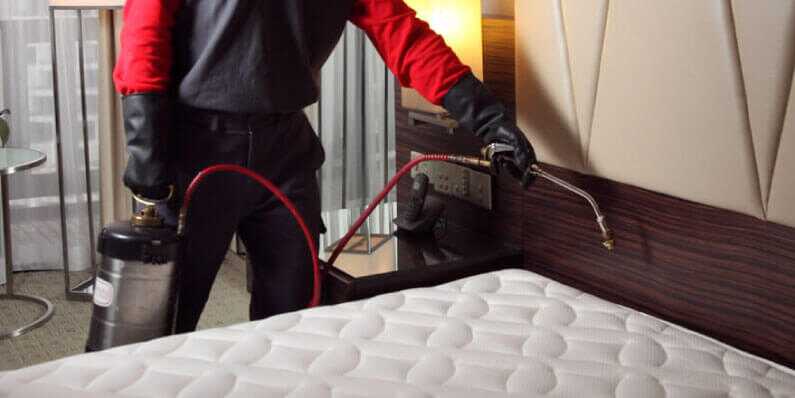Local Bed Bug Exterminator: DC Heat Treatment Providers Available
Local Bed Bug Exterminator: DC Heat Treatment Providers Available
Blog Article
Exploring the Scientific Research Behind Bed Pest Warm Treatments as a Lasting Insect Monitoring Approach
One such method that has actually gained traction in recent years is the use of heat treatments to deal with bed insect infestations. The intricacies of just how heat properly gets rid of bed bugs and the broader ramifications for sustainable insect monitoring techniques make this a topic worth exploring better.
Bed Pest Heat Therapy Process

Thermal Fatality Factor for Bed Pests
Revealing bed pests to raised temperature levels beyond their thermal resistance array is crucial for accomplishing reliable removal in heat treatment procedures. The thermal fatality factor for bed insects describes the temperature at which these bugs can not survive. Research shows that bed bugs begin to die when subjected to temperatures above 113 ° F(45 ° C) for a continual period. As the temperature increases, so does the death rate of bed bugs. At around 118 ° F(48 ° C ), bed bugs begin to pass away swiftly, with a mortality price of nearly 99% within minutes of exposure. This demonstrates the level of sensitivity of bed pests to high temperature levels and highlights the efficiency of heat therapies in eliminating problems. By reaching and maintaining temperatures above the thermal fatality point for bed insects, parasite administration experts can make sure comprehensive removal of bed pest populaces, consisting of hard-to-reach locations where chemical therapies may be less efficient. Understanding the thermal death factor for bed pests is essential for carrying out successful warmth treatment strategies and achieving lasting pest management end results.
Benefits of Heat Treatments
Having developed the vital thermal fatality factor for bed pests, it is necessary to currently check out the considerable benefits that heat treatments supply in properly removing these resistant parasites. Warm treatments existing numerous essential benefits when contrasted to standard chemical techniques. Among the primary advantages is that warm can permeate deep into fractures and holes where bed insects hide, making sure that also one of the most hard-to-reach areas are heated up to dangerous temperature levels. This extensive method not just kills online bugs yet likewise targets bed bug eggs, avoiding future problems.
Furthermore, warmth therapies are non-toxic and ecologically pleasant, making them a lasting parasite administration technique. Unlike chemical pesticides, warmth treatments do not leave unsafe residues that can pose dangers to human health and wellness or the setting. This facet is especially important in sensitive environments such as hospitals, colleges, and suburbs where chemical usage may not be preferable.
In addition, warmth therapies have a high success rate in eliminating bed pest problems in a single treatment, reducing the demand for several check outs and lessening interruption to occupants. This efficiency not only saves money and time but also provides comfort to those taking care of bed pest problems.
Efficiency of Heat Therapy

Research researches have actually consistently demonstrated the effectiveness of warmth therapies in attaining a high rate of bed pest death. Appropriately performed warm treatments can get to all the holes and splits where bed insects might be harboring, guaranteeing an extensive technique to extermination. Furthermore, heat therapies have the included advantage of killing bed insect eggs, which are commonly immune to typical chemical therapies. On the whole, the efficiency of warm treatments in eliminating bed insect problems makes them a trustworthy and lasting parasite monitoring strategy.
Sustainable Insect Monitoring Advantages
Implementing sustainable parasite management techniques uses lasting benefits for both the environment and public wellness. By utilizing techniques such as warmth therapies for pest control, we can lower the reliance on damaging chemical pesticides that can have unfavorable effects on ecological communities and human health and wellness - bed bug heat treatment. Sustainable parasite management methods aid in protecting biodiversity by targeting specific insects exterminator without damaging non-target microorganisms, consequently keeping a balanced ecosystem
Additionally, sustainable parasite administration methods contribute to the total wellness and well-being of the public. By lessening exposure to harmful chemicals used in traditional bug control techniques, warm treatments offer a safer option for bug administration in household, industrial, and public spaces. This her latest blog decrease in chemical use additionally aids in preventing chemical residues from infecting water, air, and soil, guarding environmental top quality.
Verdict
Finally, bed insect heat treatments have actually been revealed to be a lasting and effective insect management method. The thermal fatality factor for bed pests makes them prone to warmth therapies, which have various advantages over traditional chemical therapies. The effectiveness of warm treatments in removing bed insect problems while decreasing ecological influence highlights the possibility of this approach as a sustainable option for parasite control.
The bed bug heat therapy process includes increasing the temperature within ravaged areas to a level that efficiently eliminates bed bugs and their eggs. By getting to and preserving temperatures above the thermal fatality point for bed pests, bug management specialists can guarantee detailed removal of bed bug populaces, consisting of hard-to-reach locations where chemical therapies may be much less effective. One of the primary advantages is that warmth can penetrate deep into holes and cracks where bed pests hide, making sure that also the most hard-to-reach locations are warmed to dangerous temperatures. Unlike chemical therapies that might leave behind resistant populations, warm treatments offer a non-toxic and ecologically friendly option that can pass through deep into furniture, wall surfaces, and other hard-to-reach areas where bed insects conceal.
The thermal fatality factor for bed pests makes them at risk to heat therapies, which have numerous discover this benefits over typical chemical therapies.
Report this page